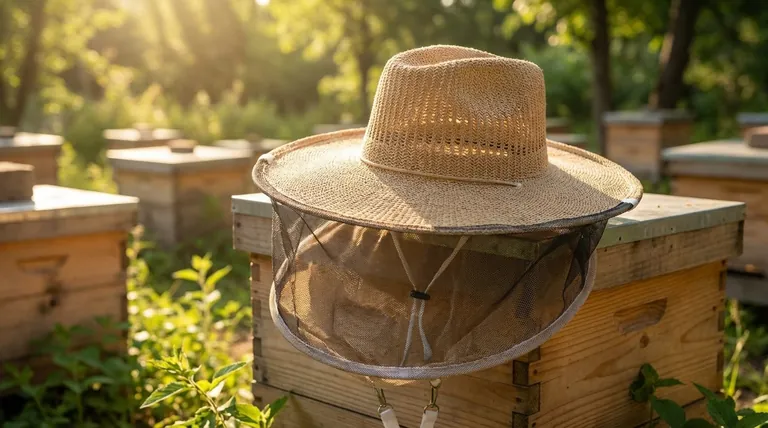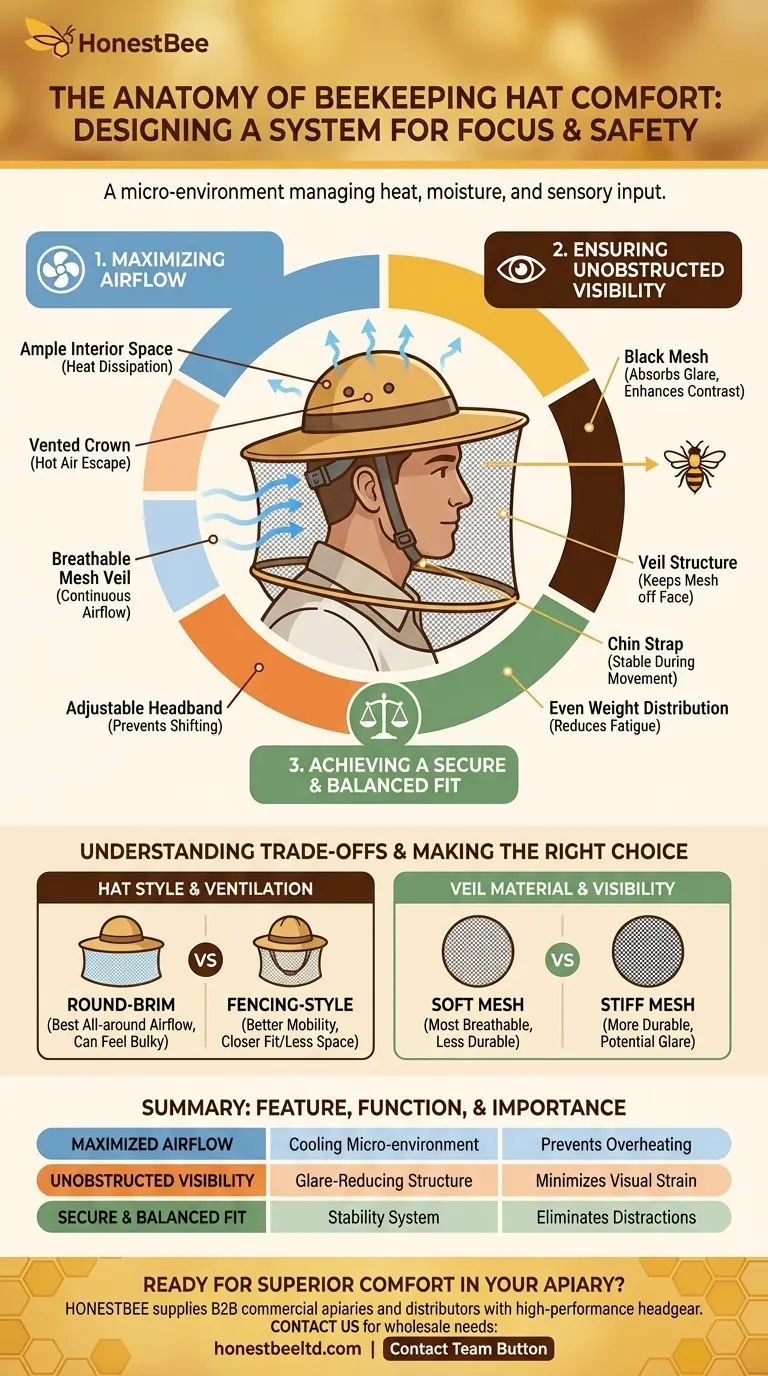A beekeeping hat ensures comfort through a deliberate design that prioritizes airflow, visibility, and a stable fit. The combination of ample interior space to dissipate heat, a non-obstructive veil for clear sightlines, and a secure fit prevents the fatigue and distraction that can make long beekeeping sessions unbearable.
The comfort of a beekeeping hat is not a single feature but a system. It's about designing a micro-environment for your head that manages heat, moisture, and sensory input, allowing you to remain focused, calm, and safe while working.

The Anatomy of Comfort: Beyond Simple Protection
Effective headgear does more than just stop stings; it mitigates the environmental challenges of beekeeping. Comfort is a critical component of safety, as a distracted or overheated beekeeper is more likely to make mistakes.
Principle 1: Maximizing Airflow
A primary source of discomfort is trapped heat and humidity. A well-designed hat directly combats this.
The ample interior space mentioned in its design is not just for roominess. It creates a buffer of air that can circulate, drawing heat and moisture away from your head and face.
Hats often incorporate lightweight, breathable fabrics in the crown or even have built-in ventilation grommets. This works in concert with the mesh veil to create a constant, passive airflow.
Principle 2: Ensuring Unobstructed Visibility
Visual fatigue is a significant and often overlooked strain. Your hat's veil is a critical component for comfort.
A clear and unobstructed view is paramount. The best veils use black mesh, which absorbs light and reduces glare, making it easier to see into the hive and spot eggs or queen cells.
The structure of the hat is designed to keep this mesh away from your face. A veil that constantly brushes against your skin or eyelashes is a major source of irritation and distraction.
Principle 3: Achieving a Secure and Balanced Fit
A hat that slips, shifts, or feels unbalanced is a constant annoyance that detracts from your work.
Modern beekeeping hats often include an adjustable headband or chin strap. This ensures the hat remains stable as you bend and move, preventing the need for constant readjustment.
A proper fit reduces physical fatigue. It ensures the hat's weight is distributed evenly and prevents chafing or pressure points during long hours in the apiary.
Understanding the Trade-offs: Comfort vs. Durability
Choosing a beekeeping hat involves balancing competing design priorities. What makes a hat comfortable in one area might be a compromise in another.
Hat Style and Ventilation
Round-brim hats typically offer the best all-around ventilation, as they hold the veil out in a wide circle. However, they can feel bulky.
Fencing-style veils, which are integrated into a hood, offer better mobility and are less likely to get caught on objects. This tighter fit, however, can sometimes reduce the feeling of spaciousness and airflow around the face.
Veil Material and Visibility
The most breathable veils are often made of a softer, more flexible mesh. The trade-off is that these can be less durable and more susceptible to tearing than stiffer, coated mesh alternatives.
A stiffer veil may last longer but can be more difficult to see through if it catches glare and may feel more restrictive.
Making the Right Choice for Your Goal
Select your headgear based on your specific climate, work style, and priorities.
- If your primary focus is maximum ventilation in hot climates: Choose a wide, round-brimmed hat with a vented crown and a soft, highly breathable mesh veil.
- If your primary focus is durability for frequent, rugged use: Consider a hat with a stiffer, coated mesh veil that can withstand more wear and tear.
- If your primary focus is mobility and working in tight spaces: A fencing-style veil and hood combination may provide a more streamlined and less cumbersome fit.
The right headgear allows you to forget you are wearing it and focus entirely on the well-being of your bees.
Summary Table:
| Comfort Feature | How It Works | Why It Matters |
|---|---|---|
| Maximized Airflow | Ample interior space, breathable fabrics, and ventilation grommets create a cooling micro-environment. | Reduces heat and humidity buildup, preventing overheating and fatigue. |
| Unobstructed Visibility | Black mesh veil absorbs light to reduce glare and is structured to stay away from the face. | Minimizes visual strain, allowing you to spot eggs and queens with ease. |
| Secure & Balanced Fit | Adjustable headband or chin strap ensures stability during movement. | Eliminates distractions from a shifting hat and prevents chafing. |
Ready to experience superior comfort and focus in your apiary?
At HONESTBEE, we supply commercial apiaries and beekeeping equipment distributors with high-performance headgear designed for long-lasting comfort and durability. Our wholesale-focused operations ensure you get the reliable equipment your business depends on.
Contact our team today to discuss your wholesale needs and discover the HONESTBEE difference.
Visual Guide

Related Products
- Beekeeper Cowboy Hat and Veil for Beekeeping
- Heavy Duty Cowboy Beekeeper Hat with Visibility Veil Outdoor Professional Beekeeping Protective Gear
- Cotton Beekeeping Suit and Round Hat with Veil Bee Keeper Protective Gear
- White Beekeeping Protective Suit and Hat with Fencing Veil for Beekeepers
- Professional Beekeeping Suit for Kids and Girls Childrens Bee Keeper Suit
People Also Ask
- What features enhance the quality of the beekeeping veil? Choose the Right Protection for Your Apiary
- What activities is the beekeeping hat suitable for? Beyond the Hive for Ultimate Outdoor Protection
- What are the benefits of the lightweight fabric used in the beekeeping hat veil? Enhanced Visibility & Comfort for Hive Work
- How can beekeeping supplies and accessories enhance the hobby? Essential Tools for Safe & Rewarding Beekeeping
- Why is head protection important for beekeepers? Essential Safety for Confident Hive Management



















